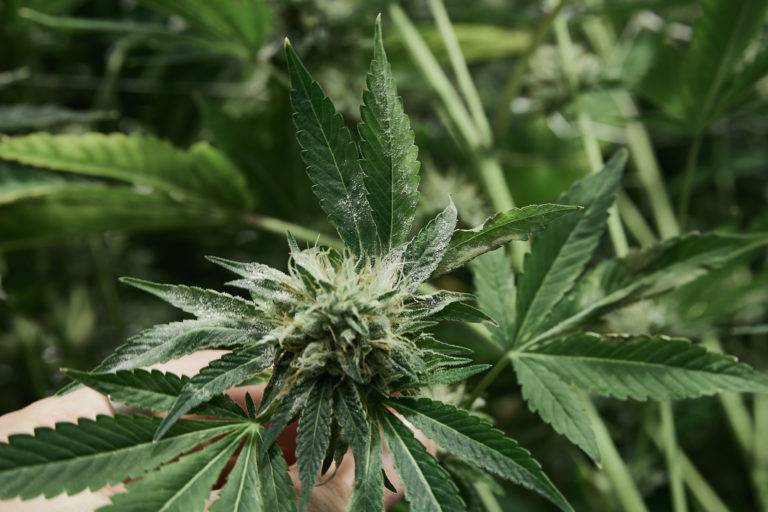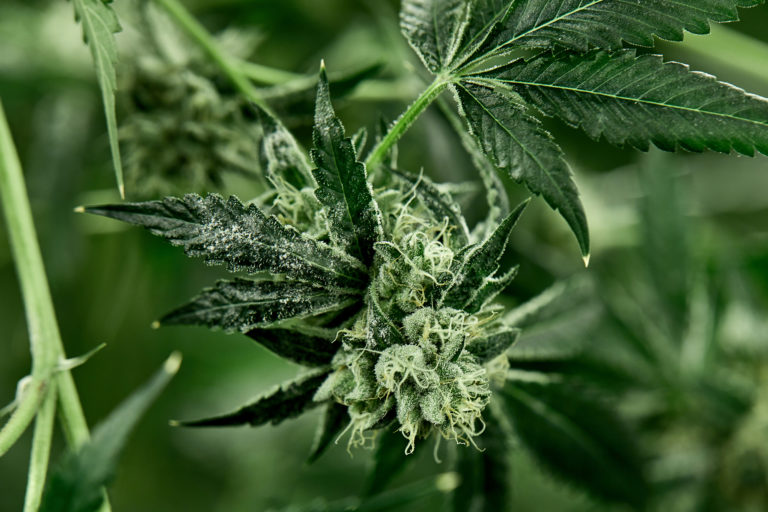Smoking moldy weed is about as appealing as eating moldy bread. Apart from looking ominous, mold also stunts cannabis growth and renders the flower unfit for consumption. Unfortunately, mold is one of the most common blights to affect cannabis plants. Here, we'll cover the telltale signs, how to prevent mold, and how to promote healthy growing conditions.
What is mold, and why is it bad?
Mold is a member of the fungus family. Mold can grow both indoors and outdoors, only requiring damp environments with limited airflow to thrive. Once established, mold begins producing filaments called mycelium and forming airborne spores invisible to the naked eye. When these spores land on a moist surface, more mold begins to grow and the cycle starts again. Although mold represents a vital part of the ecosystem, it's not something you want to see growing on your cannabis.
 Photo by: Gina Coleman/Weedmaps
Photo by: Gina Coleman/WeedmapsImage lightbox

Problematically, mold spores carry toxic chemicals called mycotoxins. Mycotoxins are usually inhaled and can represent a serious threat to health in immunocompromised individuals. In some cases, the ingestion of certain mycotoxins, such as aspergillus, can even be fatal. Smoking moldy weed should be avoided in general as it can lead to sinus and lung inflammation, undermining the potential therapeutic benefits cannabis may offer.
“Mold has been linked to many health challenges, including the worsening of asthma, coughing, wheezing, nasal congestion, sore throat, sneezing, and rhinitis,” says Steve Sakala, longtime cannabis cultivator and founder of Mana Artisan Botanics. “Chronic mold exposure can also lead to the scarring of the lungs or pulmonary fibrosis. There are also reports linking it to chronic fatigue syndrome and other long-term symptoms.”
What do moldy cannabis plants look like?
While mold is often used as a catch-all phrase to refer to this unwelcome fungal visitor, there are distinctive types of mold. “There are many types of mold, but the two most common forms of mold found on cannabis plants are powdery mildew and botrytis,” explains Sakala. Another common variant is sooty mold.
Picking out the signs of different molds in the early stages can help protect your crop. A black light or magnifying glass can also render it easier to pick out mycelium that's getting established.
Botrytis (bud rot)
Botrytis is known more colloquially among growers as grey mold or bud rot. Grey mold can occur in both growing plants and dried buds, but is more common in outdoor plots after heavy rainfall or humidity.
The fungus often originates inside dense, moist buds before becoming visible on the outside. Bud rot can enter the tissue and remain dormant until the environment becomes conducive to its spread, then it rapidly rots tissue. This particular mold produces enzymes and toxins that destroy the cell walls of cannabis plants. Research suggests that the mold triggers the plant host to induce its own cellular death.
Because it lurks in buds, it can be tricky to identify. “Bud rot is harder to spot as it usually develops in the interior of mature buds, progressively reaches the exterior, until it takes over the whole bud,” explains Josh Ferranto, cultivation expert and chief operating officer at Silver Therapeutics.
Here are some signposts that point to bud rot:
- Dying or yellowing leaves close to the cola
- Colas that look limp or discolored
- Patches of brown or grey that look lifeless
- Plant tissue that crumbles to the touch and feels dry
The easiest way to confirm the presence of botrytis is to break apart suspicious-looking buds to check if the dark mold is concealed inside.
Powdery mildew
Mildew is easily recognizable by its powdery appearance. It's commonly found on the surface of leaves and flowers, unlike bud rot, which appears deeper within buds. To the unpracticed eye, bud mildew can be confused with young trichomes, which are white and glittery in appearance.
 Photo by: Gina Coleman/Weedmaps
Photo by: Gina Coleman/WeedmapsImage lightbox

“Powdery mildew exists almost anywhere in nature that there is moisture and affects cannabis particularly if there is a lack of airflow,” says Sakala. “The biggest concern for cannabis growers is if the mildew appears on flowers.” If left unchecked, powdery mildew can quickly become a systemic problem.
Here are some tips to help identify powdery mildew:
- The presence of circular, white spots that look like a light dusting of flour
- White spots on the upper side of leaves rather than the underside
- The yellowing and drying out of young leaves
- The disfiguration of more mature plants, particularly as the mildew progresses
Sooty mold
Predictably, sooty mold looks like soot. Unlike other forms of mold that launch a direct attack on the cannabis plant, sooty mold grows in the secretions of common garden pests. If your crop has been infested with aphids or whiteflies, you're likely to experience sooty mold as well. Sooty mold is more common in indoor grows.
The following signs point to sooty mold:
- Small, dark black patches on fan leaves
- Hindered plant growth due to impeded photosynthesis
- A grimy appearance to the affected areas
- Stickiness in the affected areas
- Yellowing foliage as the mold obstructs sunlight
What causes moldy marijuana?
Cannabis thrives in warm conditions that can sometimes create the ideal environment for mold to grow. As cannabis plants absorb water and nutrients they also transpire, which can promote humidity, ushering in mold and mildew. Growing healthy cannabis and keeping mold at bay is a balancing act that requires vigilance from the grower.
 Photo by: Gina Coleman/Weedmaps
Photo by: Gina Coleman/WeedmapsImage lightbox

Mold can establish itself on cannabis plants with very little encouragement. “The spores that create mold are almost everywhere in our environment,” explains Ferranto. “In an indoor setting, lack of airflow, excessively high humidity, massive temperature swings, and low nighttime temperatures are the main causes of mold.”
Some other factors that can contribute to mold growth include:
- Overwatering
- Poor plant health
- Poor plant maintenance
- A lack of sunlight
- High humidity (note: different phases of cannabis growth have different optimal humidity levels, but humidity should never exceed 70%)
How to prevent weed from getting moldy
The best way to tackle mold is to prevent it from taking hold of your plants in the first place. Cultivating healthy growing conditions where damp and moisture aren't encouraged to linger makes it difficult for mold to become established. Promoting air circulation is pivotal. There should be enough air to rustle the leaves gently, so mold spores can't settle and spread.
“There are some clear ways to prevent mildew and molds in your cannabis crop,” says Sakala. “The first is to make sure you have sufficient airflow. Some growers choose certain pruning techniques to increase airflow, such as trimming up bottom branches and inside flower nodes.” For indoor grow rooms, Ferranto also recommends supporting airflow with fans, HVAC, and air filtration systems. Outdoor crops benefit from being planted with sufficient space between them to allow air to circulate freely.
For growers looking for a little extra muscle, organic fungicides and treatments can also keep mold at bay. “In both indoor and outdoor settings, there are organic biological fungicides such as Actinovate which can be applied to ward off mold,” says Ferranto. “These fungicides are like a probiotic for your body in which a beneficial live organism fights pathogens. Some of the older methods include burning sulfur and even baking soda.”
Sakala recommends organic treatment options, such as neem oil or products derived from neem. “Using different sprays in rotation prevents resistance from building up as well,” he advises.
Other techniques that can help to keep mold at bay include:
- Monitoring humidity (in indoor grows) and installing a dehumidifier if moisture levels become too high
- Inspecting your plants daily for signs of mold or mildew
- Maintaining a consistent temperature in your grow room
- Trimming foliage from plants towards the end of the vegetative phase to encourage air to flow towards the canopy
- Cultivating strains known for withstanding mold
- Raising plants in full sunlight for outdoor grows
- Using temporary tarps in periods of prolonged rain

